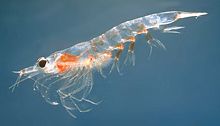Eucarida
| Eucarida | |
|---|---|

| |
| Meganyctiphanes norvegica | |
| Klasifikasi ilmiah | |
| Domain: | |
| Kerajaan: | |
| Filum: | |
| Subfilum: | |
| Kelas: | |
| Subkelas: | |
| Superordo: | Eucarida |
| Ordo | |
Eucarida adalah sebuah superordo dari Malacostraca, subfilum krustasea yang terdiri dari dekapoda, krill, dan lainnya.[2] Mereka dicirikan dengan memiliki karapaks yang menyatu dengan seluruh segmen toraks, dan memiliki mata yang bertangkai.[3]
Filogeni[sunting | sunting sumber]
Filogeni Malacostraca masih diperdebatkan.[4] Secara khusus, monopoli Eucarida juga dipertanyakan:
- Monofiletik: banyak yang berpendapat bahwa kelompok Eucarida adalah sebuah klad, saudara dari klad Peracarida[4][5] atau ke basal Malacostraca,[6][7] atau ke Mysida (Schizopoda parafiletik)[8]
- Parafiletik: beberapa ahli mengusulkan Eucarida parafiletik yang membentuk klad dengan Peracarida yang bersarang.[9]
- Polifiletik: beberapa ahli mengelompokkan Euphausiacea dengan Mysida untuk membentuk Schizopoda,[10][11] atau Euphausiacea dengan Hoplocarida,[12] dengan basal Decapoda di Peracarida.[11][12]
Referensi[sunting | sunting sumber]
- ^ "Eucarida Calman, 1904". Integrated Taxonomic Information System.
- ^ WoRMS (2010). "Eucarida". World Register of Marine Species. Diakses tanggal February 7, 2011.
- ^ L. A. Borradaile; F. A. Potts; L. E. S. Eastman; J. T. Saunders (1961). "The Class Crustacea". Dalam Gerald A. Kerkut. The Invertebrata (edisi ke-4th). Cambridge University Press. hlm. 340–419.
- ^ a b Frederick Schram (1986). Crustacea. Oxford University Press. ISBN 0-19-503742-1.
- ^ R. Siewing (1963). "Studies in malacostracan morphology: results and problems". Dalam H. B. Whittington; W. D. Rolfe. Phylogeny and Evolution of Crustacea. Cambridge, Massachusetts: Museum of Comparative Zoology. hlm. 85–103.
- ^ M. A. Wills (1998). "A phylogeny of recent and fossil Crustacea derived from morphological characters". Dalam Richard A. Fortey; Richard H. Thomas. Arthropod Relationships. Volume 55 of Systematics Association Series. Springer. hlm. 189–210. ISBN 978-0-412-75420-3.
- ^ Trisha Spears; Ronald W. DeBry; Lawrence G. Abele; Katarzyna Chodyla (2005). "Peracarid monophyly and interordinal phylogeny inferred from nuclear small-subunit ribosomal DNA sequences (Crustacea: Malacostraca: Peracarida)" (PDF). Proceedings of the Biological Society of Washington. 118 (1): 117–157. doi:10.2988/0006-324X(2005)118[117:PMAIPI]2.0.CO;2.
- ^ L. Watling (1999). "Towards understanding the relationship of the peracaridan orders: the necessity of determining exact homologies". Dalam Frederick R. Schram; J. Carel von Vaupel Klein. Crustaceans and the Biodiversity Crisis. Proceedings of the Fourth International Crustacean Congress, Amsterdam: The Netherlands, July 20–24, 1998, Vol. I. Brill Publishers. hlm. 73–89. ISBN 978-90-04-11387-9.
- ^ Stefan Richter; Gerhard Scholtz (2001). "Phylogenetic analysis of the Malacostraca (Crustacea)". Journal of Zoological Systematics and Evolutionary Research. 39 (3): 113–136. doi:10.1046/j.1439-0469.2001.00164.x
 .
.
- ^ Georg Ossian Sars (1870). Carcinologiske Bidrag til Norges Fauna over de ved Norges Kysters forekommende Mysider. Vol. 1. Christiana: Brøgger & Christies Bogtrykkeri.
- ^ a b Simon N. Jarman; Stephen Nicol; Nicholas G. Elliott; Andrew McMinn (2000). "28S rDNA evolution in the Eumalacostraca and the phylogenetic position of krill". Molecular Phylogenetics and Evolution. 17 (1): 26–36. doi:10.1006/mpev.2000.0823. PMID 11020302.
- ^ a b K. Meland; E. Willassen (2007). "The disunity of "Mysidacea" (Crustacea)" (PDF). Molecular Phylogenetics and Evolution. 44 (3): 1083–1104. doi:10.1016/j.ympev.2007.02.009. PMID 17398121.
